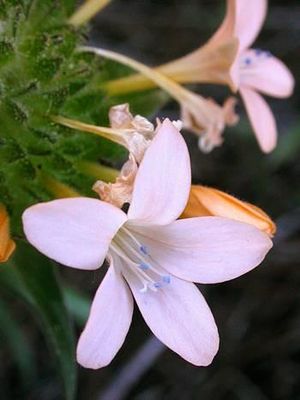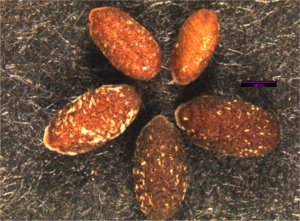Difference between revisions of "Collomia grandiflora"
(→Bloom Period) |
|||
| Line 1: | Line 1: | ||
| − | * | + | * Scientific Name: ''Collomia'' ''grandiflora'' |
* Family: Polemoniaceae | * Family: Polemoniaceae | ||
* Common Names: large-flowered collomia, large-flower mountain-trumpet | * Common Names: large-flowered collomia, large-flower mountain-trumpet | ||
* Codon: COLGRA | * Codon: COLGRA | ||
| − | + | [[File:COGRX BenLegler flw good.jpg |thumb|Photo by Ben Legler, 2004. Also featured on Main Page]] | |
| − | == Taxonomy == | + | === Taxonomy === |
{{Taxobox | {{Taxobox | ||
| − | | name = | + | | name = |
| − | | image = | + | | image = |
| image_caption =Photo by Ben Legler, 2004. Also featured on Main Page | | image_caption =Photo by Ben Legler, 2004. Also featured on Main Page | ||
| regnum = [[Plant]]ae | | regnum = [[Plant]]ae | ||
| Line 22: | Line 22: | ||
<ref>Integrated Taxonomic Information System. Retrieved from https://www.itis.gov/servlet/SingleRpt/SingleRpt?search_topic=TSN&search_value=31037</ref> | <ref>Integrated Taxonomic Information System. Retrieved from https://www.itis.gov/servlet/SingleRpt/SingleRpt?search_topic=TSN&search_value=31037</ref> | ||
| − | == Description == | + | === Description === |
General: Annual, the stem simple or branched, erect, 0.5-5 dm. tall, minutely pubescent. | General: Annual, the stem simple or branched, erect, 0.5-5 dm. tall, minutely pubescent. | ||
| Line 31: | Line 31: | ||
Fruit: Capsule opening along 4 lines. | Fruit: Capsule opening along 4 lines. | ||
| − | == Bloom Period == | + | === Bloom Period === |
April - June | April - June | ||
| − | == Distribution == | + | === Distribution === |
West of the Cascade summits, British Columbia to California, and in the Columbia River Gorge. | West of the Cascade summits, British Columbia to California, and in the Columbia River Gorge. | ||
| − | == Habitat == | + | === Habitat === |
Open, moist to rather dry areas, low to moderate elevations in the mountains. Moist to drier soil – not heat-resistant and requires cool nights. | Open, moist to rather dry areas, low to moderate elevations in the mountains. Moist to drier soil – not heat-resistant and requires cool nights. | ||
| − | == Uses == | + | === Uses === |
Infusion of roots or of leaves and stalks taken by Okanogan-Colville as a laxative; Infusion of roots taken by Okanogan-Colville for high fevers; Leaves used by Paiute and others as a protective covering for filled berry containers. | Infusion of roots or of leaves and stalks taken by Okanogan-Colville as a laxative; Infusion of roots taken by Okanogan-Colville for high fevers; Leaves used by Paiute and others as a protective covering for filled berry containers. | ||
| − | == Propagation == | + | === Propagation === |
Sow seeds in both the fall and early spring for the maximum season of flowering. | Sow seeds in both the fall and early spring for the maximum season of flowering. | ||
| Line 73: | Line 73: | ||
{{Basics}} | {{Basics}} | ||
| − | = | + | === Photo Gallery === |
| − | == Photo Gallery == | + | |
<gallery> | <gallery> | ||
File:COGRX BenLegler flw1 good.jpg|Photo: Ben Legler | File:COGRX BenLegler flw1 good.jpg|Photo: Ben Legler | ||
| Line 80: | Line 79: | ||
File:COLGRA3.jpg|Young growth, courtesy of CNLM | File:COLGRA3.jpg|Young growth, courtesy of CNLM | ||
</gallery> | </gallery> | ||
| + | ===References=== | ||
Revision as of 13:18, 20 March 2021
- Scientific Name: Collomia grandiflora
- Family: Polemoniaceae
- Common Names: large-flowered collomia, large-flower mountain-trumpet
- Codon: COLGRA
Contents
Taxonomy
| Scientific classification | |
|---|---|
| Kingdom: | Plantae |
| Subkingdom: | Viridiplantae |
| Phylum: | Tracheophyta |
| Subphylum: | Spermatophytina |
| Class: | Magnoliopsida |
| Subclass: | Asteranae |
| Order: | Ericales |
| Family: | Polemoniaceae |
| Genus: | Collomia Nutt. |
| Species: | Collomia grandiflora Douglas ex. Lindl |
Description
General: Annual, the stem simple or branched, erect, 0.5-5 dm. tall, minutely pubescent.
Leaves: Lower leaves opposite, petiolate, often toothed when well developed; upper leaves opposite or whorled, entire, usually glabrous, becoming sessile upward, narrowly elliptic or oblong to nearly linear.
Flowers: Flowers 1-few on short pedicels in the axils of reduced upper leaves; calyx 5-8 mm. long, 5-lobed; corolla bi-labiate, blue with white or pinkish upper lip, 9-17 mm. long, the tube abruptly bent at a right angle to the calyx, shortly pouched at the bend; stamens 4.
Fruit: Capsule opening along 4 lines.
Bloom Period
April - June
Distribution
West of the Cascade summits, British Columbia to California, and in the Columbia River Gorge.
Habitat
Open, moist to rather dry areas, low to moderate elevations in the mountains. Moist to drier soil – not heat-resistant and requires cool nights.
Uses
Infusion of roots or of leaves and stalks taken by Okanogan-Colville as a laxative; Infusion of roots taken by Okanogan-Colville for high fevers; Leaves used by Paiute and others as a protective covering for filled berry containers.
Propagation
Sow seeds in both the fall and early spring for the maximum season of flowering.
Seed
Abbreviation: COGRX
Seed sample from: 2011
Average measurement: 3 x 1.5 x 1.1
Measurement range: L: 2.75 - 3.1 W: 1.2 x 1.7 D: 0.9 x 1.3
Features
Shape: One end of seed is slightly more rounded than other. This is the hilium end. One side of seed has longitudinal sulcus that does not reach the hilium or opposite apex.
Color: Hilium indistinct. Entire seed surface mostly uniform in color. Seed is brown with some white spots that are flakey looking.
Surface:Entire seed is very bumpy, sometimes slightly ridged. When wet, seed coat forms many clear, mucilaginous threads.
Could be confused with: Gilia capitata
Latitudinal cross section: elliptical ![]()
Longitudinal cross section: elliptical ![]()
Basic Explanations and Assumptions:
The dimensions for the seeds are length x width x depth. The location of the hilum is used as the base of the seed, and the length is measured from hilum to the opposite apex. Where a style is present, the length is measured from the hilum to the bottom of the style. Width is measured at a right angle to the length at the widest part. Depth is measured at a right angle to the intersection of height and width lines.
Measurements included are the mean average for each measurement of ten separate seeds.
All measurements in millimeters unless otherwise noted.
Photo Gallery
References
- ↑ Integrated Taxonomic Information System. Retrieved from https://www.itis.gov/servlet/SingleRpt/SingleRpt?search_topic=TSN&search_value=31037





